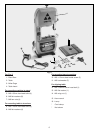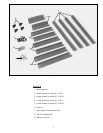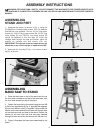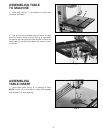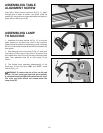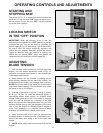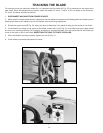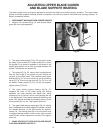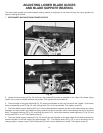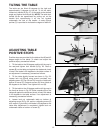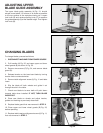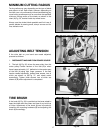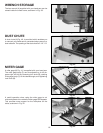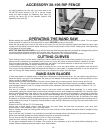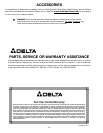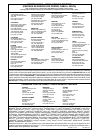
19
Fig. 43
An ideal accessory for use with your band saw is the
28-196 Rip Fence, shown in Fig. 43. It can be moved
along the table surface by loosening lock lever (A),
moving the fence (B) to the desired location and
tightening lock lever (A).
ACCESSORY 28-196 RIP FENCE
OPERATING THE BAND SAW
Before starting the machine, see that all adjustments are properly made and the guards are in place. Turn the upper
wheel by hand to make sure that everything is correct BEFORE turning on the power.
Keep the top guide down close to the work at all times. Do not force the material against the blade too hard. Light
contact with the blade will permit easier following of the line and prevent undue friction, heating and work-hardening
of the blade at its back edge.
KEEP THE SAW BLADE SHARP and you will find that very little forward pressure is required for average cutting. Move
the stock against the blade steadily and no faster than will give an easy cutting movement.
Avoid twisting the blade by trying to turn sharp corners. Remember, you must saw around corners.
CUTTING CURVES
When cutting curves, turn the stock carefully so that the blade may follow without being twisted. If a curve is so
abrupt that it is necessary to repeatedly back up and cut a new kerf, either a narrower blade is needed or a blade
with more set is required. The more set a blade has, the easier it will allow the stock to be turned, but the cut is
usually rougher than where a medium amount of set is used.
In withdrawing the piece being cut, in order to change the cut, or for any other reason, the operator must be careful
that he does not accidentally draw the blade off the wheels. In most cases, it is easier and safer to turn the stock and
saw out through the waste material, rather than try to withdraw the stock from the blade.
BAND SAW BLADES
A band saw blade is a delicate piece of steel that is subjected to tremendous strain. You can obtain long use from a
band saw blade if you give it fair treatment. Be sure you use blades of the proper thickness, width and temper for the
various types of material to be cut.
Always use the widest blade possible. Use the narrow blades only for sawing small, abrupt curves and for fine,
delicate work. This will save blades and will produce better work. Band saw blades may be purchased, welded, set
and sharpened ready for use. For cutting wood and similar materials, Delta can supply blades in widths of 1/8, 1/4,
3/8, and 1/2 inches.
Any one of a number of conditions may cause a band saw blade to break. Blade breakage is, in some cases,
unavoidable, being the natural result of the peculiar stresses to which such blades are subjected. It is, however, often
due to avoidable causes, most often to lack of care or judgment on the part of the operator in mounting or adjusting
the blade or guides. The most common causes of blade breakage are: (1) faulty alignments and adjustments of the
guides; (2) forcing or twisting a wide blade around a curve of short radius; (3) feeding too fast; (4) dullness of the teeth
or absence of sufficient set; (5) excessive tensioning of the blade; (6) top guide set too high above the work being cut; (7)
using a blade with a lumpy or improperly finished braze or weld; and (8) continuous running of the saw blade when not in
use for cutting.
Blades for the 28-195 are 72-1/2 inches long.
Always use a sharp blade. Keep it free from gum and pitch. Keep the tires free of sawdust, gum, and pitch
accumulation. Clean frequently with a stiff fiber brush.
Narrow blades are used for cutting small circles or curves while the wider blades are best suited for straight cutting
such as ripping.
Due to the low cost of blades, it is advisable to purchase new blades rather than attempt to have them sharpened.
Make sure the blade guides are always adjusted properly as previously outlined.
Do not force or twist the blade around a curve or a very short radius.
Feed the work uniformly, allowing the blade to cut – do not feed too fast.
Do not apply excessive tension on blades. The tension is only necessary to drive the blade without slipping on the
wheels. Narrow blades require less tension than wider blades.
B
A



